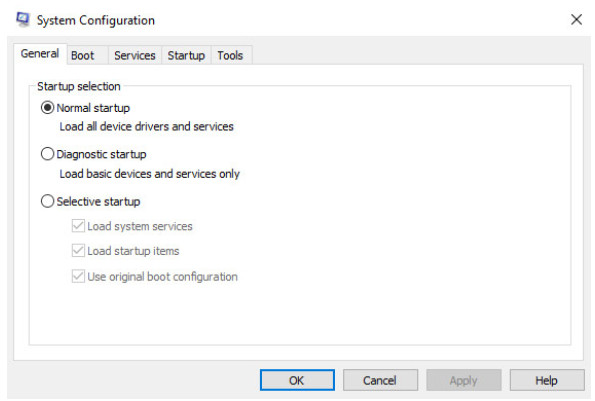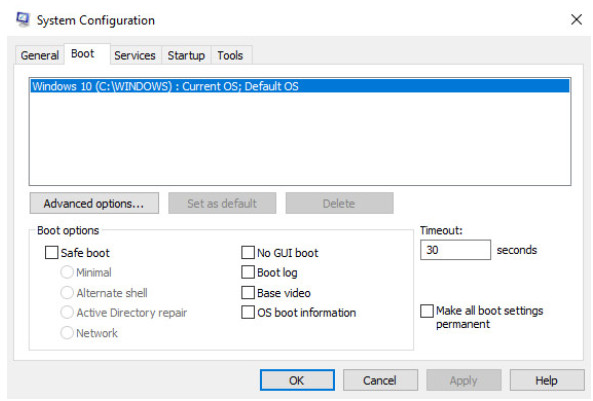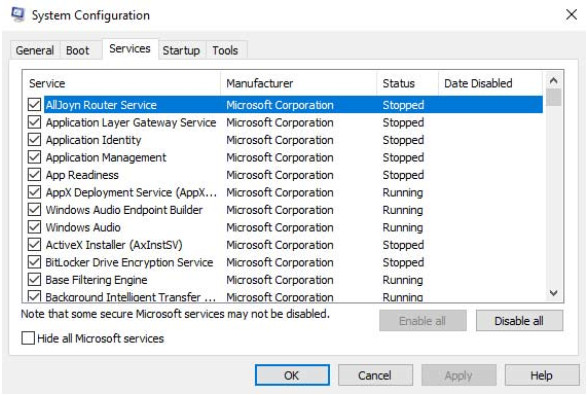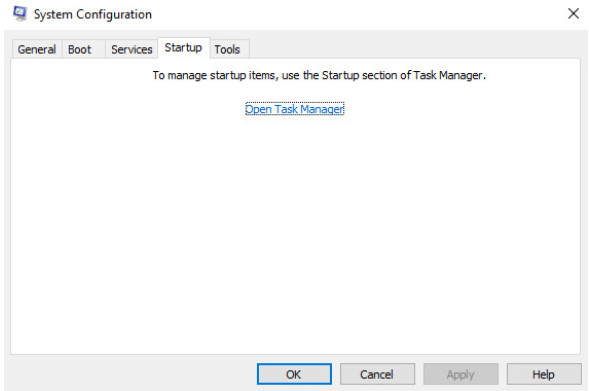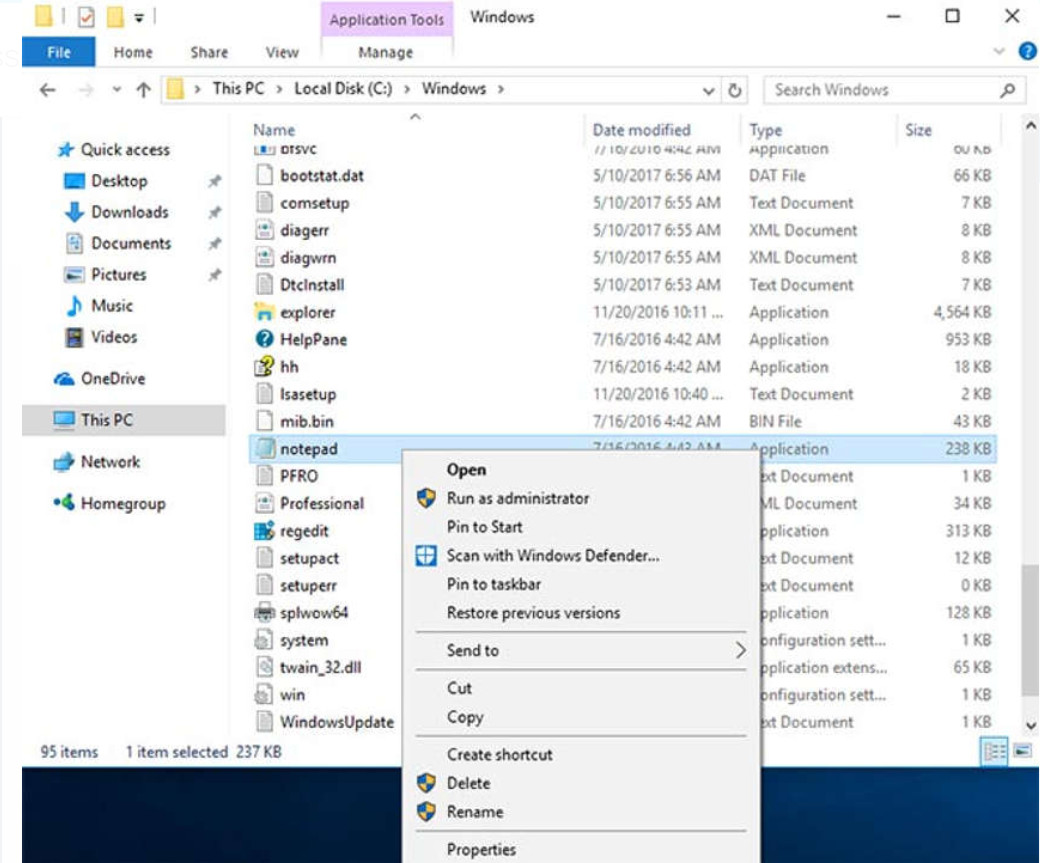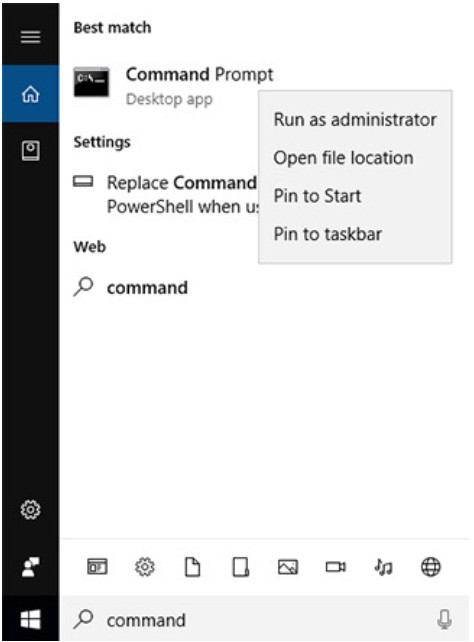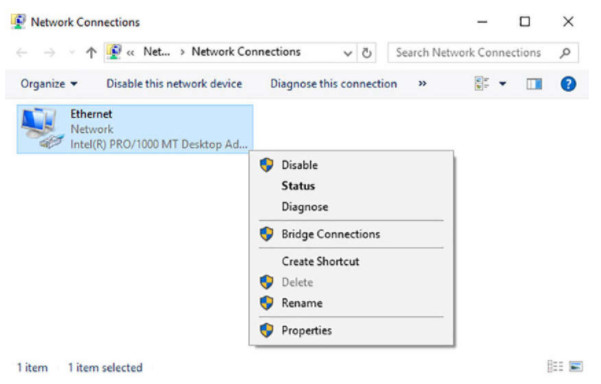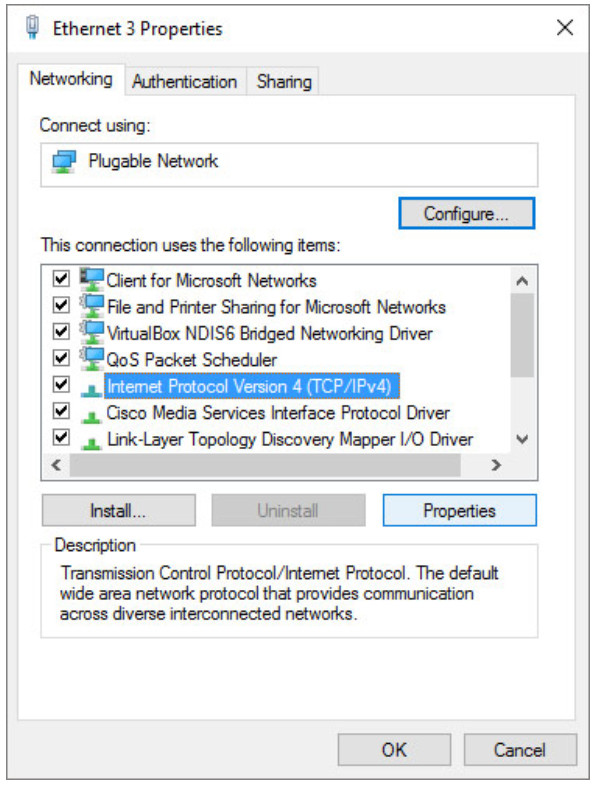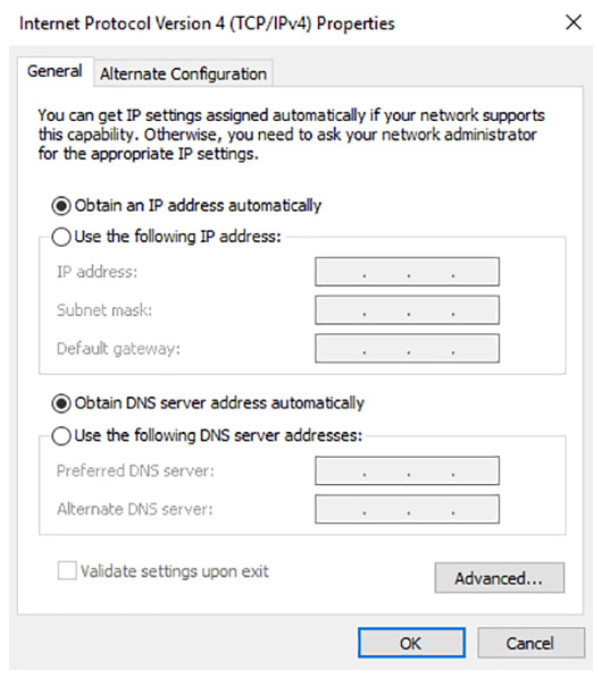3.0 Introduction
3.0.1 Why Should I Take this Module?
From its humble beginnings over 35 years ago in 1985, the Windows operating system has seen many iterations; from Windows 1.0 to today’s current desktop version, Windows 10, and server version, Windows Server 2019.
This module covers some of the basic concepts of Windows, including how the operating system works and the tools used to secure Windows endpoints.
3.0.2 What Will I Learn in This Module?
Module Title: The Windows Operating System
Module Objective: Explain the security features of the Windows operating system.
| Topic Title | Topic Objective |
|---|---|
| Windows History | Describe the history of the Windows Operating System. |
| Windows Architecture and Operations | Explain the architecture of Windows and its operation. |
| Windows Configuration and Monitoring | Explain how to configure and monitor Windows. |
| Windows Security | Explain how Windows can be kept secure. |
3.0.3 Class Activity – Identify Running Processes
In this activity, you will use TCP/UDP Endpoint Viewer, which is a tool in the Windows Sysinternals Suite, to identify running processes on your computer.
3.0.3 Class Activity – Identify Running Processes
3.1 Windows History
3.1.1 Disk Operating System
The first computers did not have modern storage devices such as hard drives, optical drives, or flash storage. The first storage methods used punch cards, paper tape, magnetic tape, and even audio cassettes.
Floppy disk and hard disk storage require software to read from, write to, and manage the data that they store. The Disk Operating System (DOS) is an operating system that the computer uses to enable these data storage devices to read and write files. DOS provides a file system which organizes the files in a specific way on the disk. Microsoft bought DOS and developed MS-DOS.
MS-DOS used a command line as the interface for people to create programs and manipulate data files, as shown in the command output. DOS commands are shown in bold text.
Starting MS-DOS...
HIMEM is testing extended memory... done.
C:\> C:\DOS\SMARTDRV.EXE /X
C:\> dir
Volume in drive C is MS-DOS_6
Volume Serial Number is 4006-6939
Directory of C:\
DOS <DIR> 05-06-17 1:09p
COMMAND COM 54,645 05-31-94 6:22a
WINA20 386 9,349 05-31-94 6:22a
CONFIG SYS 71 05-06-17 1:10p
AUTOEXEC BAT 78 05-06-17 1:10p
5 file(s) 64,143 bytes
517,021,696 bytes free
C:\>
With MS-DOS, the computer had a basic working knowledge of how to access the disk drive and load the operating system files directly from disk as part of the boot process. When it was loaded, MS-DOS could easily access the disk because it was built into the operating system.
Early versions of Windows consisted of a Graphical User Interface (GUI) that ran over MS-DOS, starting with Windows 1.0 in 1985. The disk operating system still controlled the computer and its hardware. A modern operating system like Windows 10 is not considered a disk operating system. It is built on Windows NT, which stands for “New Technologies”. The operating system itself is in direct control of the computer and its hardware. NT is an OS with support for multiple user processes. This is much different than the single-process, single-user MS-DOS.
Today, many things that used to be accomplished through the command line interface of MS-DOS can be accomplished in the Windows GUI. You can still experience what it was like to use MS-DOS by opening a command window, but what you see is no longer MS-DOS, it is a function of Windows. To experience a little of what it was like to work in MS-DOS, open a command window by typing cmd in Windows Search and pressing Enter. The table lists some commands that you can use. Enter help followed by the command to learn more about the command.
| MS-DOS Command | Description |
|---|---|
| dir | Shows a listing of all the files in the current directory (folder) |
| cd directory | Changes the directory to the indicated directory |
| cd .. | Changes the directory to the directory above the current directory |
| cd \ | Changes the directory to the root directory (often C:) |
| copy source destination | Copies files to another location |
| del filename | Deletes one or more files |
| find | Searches for text in files |
| mkdir directory | Creates a new directory |
| ren oldname newname | Renames a file |
| help | Displays all the commands that can be used, with a brief description |
| help command | Displays extensive help for the indicated command |
3.1.2 Windows Versions
Since 1993, there have been more than 20 releases of Windows that are based on the NT operating system. Most of these versions were for use by the general public and businesses because of the file security offered by the file system that was used by the NT OS. Businesses also adopted NT OS-based Windows operating systems. This is because many editions were built specifically for workstation, professional, server, advanced server, and datacenter server, to name just a few of the many purpose-built versions.
Beginning with Windows XP, a 64-bit edition was available. The 64-bit operating system was an entirely new architecture. It had a 64-bit address space instead of a 32-bit address space. This is not simply twice the amount of space because these bits are binary numbers. While 32-bit Windows can address a little less than 4 GB of RAM, 64-bit Windows can theoretically address 16.8 million terabytes. When the OS and the hardware all support 64-bit operation, extremely large data sets can be used. These large data sets include very large databases, scientific computing, and manipulation of high definition digital video with special effects. In general, 64-bit computers and operating systems are backward-compatible with older, 32-bit programs, but 64-bit programs cannot be run on older, 32-bit hardware.
With each subsequent release of Windows, the operating system has become more refined by incorporating more features. Windows 7 was offered with six different editions, Windows 8 with as many as five, and Windows 10 with eight different editions! Each edition not only offers different capabilities, but also different price points. Microsoft has said that Windows 10 is the last version of Windows, and that Windows has become a service rather than just an OS. They say that rather than purchasing new operating systems, users will just update Windows 10 instead.
The table lists common Windows versions.
| OS | Versions |
|---|---|
| Windows 7 | Starter, Home Basic, Home Premium, Professional, Enterprise, Ultimate |
| Windows Server 2008 R2 | Foundation, Standard, Enterprise, Datacenter, Web Server, HPC Server, Itanium-Based Systems |
| Windows Home Server 2011 | None |
| Windows 8 | Windows 8, Windows 8 Pro, Windows 8 Enterprise, Windows RT |
| Windows Server 2012 | Foundation, Essentials, Standard, Datacenter |
| Windows 8.1 | Windows 8.1, Windows 8.1 Pro, Windows 8.1 Enterprise, Windows RT 8.1 |
| Windows Server 2012 R2 | Foundation, Essentials, Standard, Datacenter |
| Windows 10 | Home, Pro, Pro Education, Enterprise, Education, loT Core, Mobile, Mobile Enterprise |
| Windows Server 2016 | Essentials, Standard, Datacenter, Multipoint Premium Server, Storage Server, Hyper-V Server |
3.1.3 Windows GUI
Windows has a graphical user interface (GUI) for users to work with data files and software. The GUI has a main area that is known as the Desktop, shown in the figure.
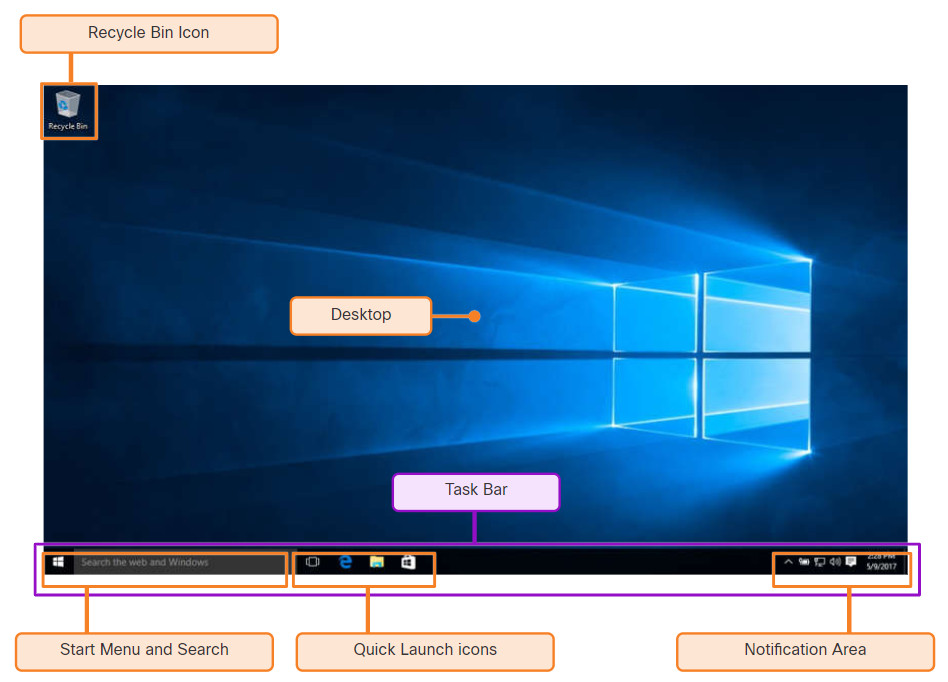
The Desktop can be customized with various colors and background images. Windows supports multiple users, so each user can customize the Desktop to their liking. The Desktop can store files, folders, shortcuts to locations and programs, and applications. The Desktop also has a recycle bin icon, where files are stored when the user deletes them. Files can be restored from the recycle bin or the recycle bin can be emptied of files, which truly deletes them.
At the bottom of the desktop is the Task Bar. The Task Bar has three areas that are used for different purposes. At the left is the Start menu. It is used to access all of the installed programs, configuration options, and the search feature. At the center of the Task Bar, users place quick launch icons that run specific programs or open specific folders when they are clicked. Finally, on the right of the Task Bar is the notification area. The notification area shows, at a glance, the functionality of many different programs and features. For example, a blinking envelope icon may indicate new email, or a network icon with a red “x” may indicate a problem with the network.
Often, right-clicking an icon will bring up additional functions that can be used. This list is known as a Context Menu, shown in the figure.

There are Context Menus for the icons in the notification area, for quick launch icons, system configuration icons, and for files and folders. The Context Menu provides many of the most commonly used functions by just clicking. For example, the Context Menu for a file will contain such items as copy, delete, share, and print. To open folders and manipulate files, Windows uses the Windows File Explorer.
3.1.4 Operating System Vulnerabilities
Operating systems consist of millions of lines of code. Installed software can also contain millions of lines of code. With all this code comes vulnerabilities. A vulnerability is some flaw or weakness that can be exploited by an attacker to reduce the viability of a computer’s information. To take advantage of an operating system vulnerability, the attacker must use a technique or a tool to exploit the vulnerability. The attacker can then use the vulnerability to get the computer to act in a fashion outside of its intended design. In general, the goal is to gain unauthorized control of the computer, change permissions, or to manipulate or steal data.
The table lists some common Windows OS Security recommendations.
| Recommendation | Description |
|---|---|
| Virus or malware protection |
|
| Unknown or unmanaged services |
|
| Encryption |
|
| Security policy |
|
| Firewall |
|
| File and share permissions |
|
| Weak or no password |
|
| Login as Administrator |
|
3.2 Windows Architecture and Operations
3.2.1 Hardware Abstraction Layer
Windows computers use many different types of hardware. The operating system can be installed on a purchased computer or a on computer that is assembled by the user. When the operating system is installed, it must be isolated from differences in hardware. The basic Windows architecture is shown in the figure.
The figure shows the basic windows architecture with the applications at the top, the User-Mode Drivers and Windows API below them, Other Kernel-Mode Drivers, Operating System Kernel, and File System Drivers below them, the Hardware Abstraction Layer below them, and at the bottom, the Hardware.
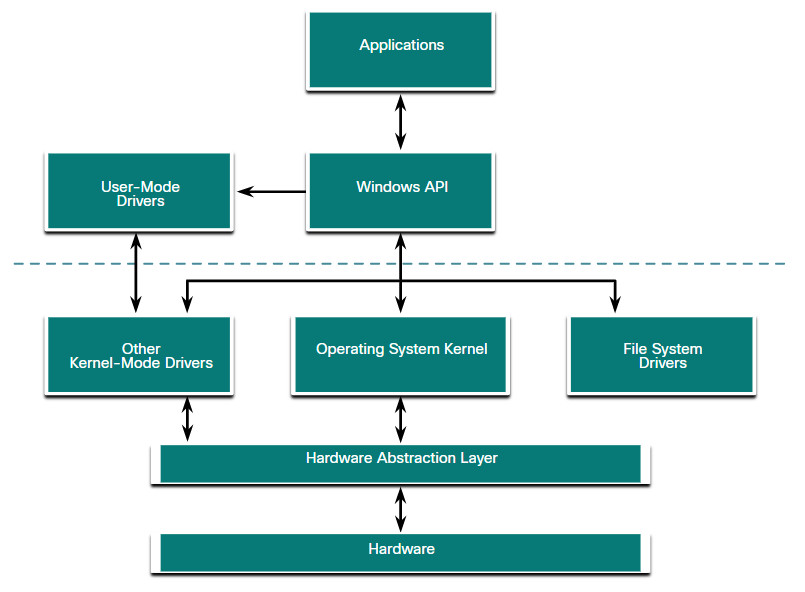
A hardware abstraction layer (HAL) is software that handles all of the communication between the hardware and the kernel. The kernel is the core of the operating system and has control over the entire computer. It handles all of the input and output requests, memory, and all of the peripherals connected to the computer.
In some instances, the kernel still communicates with the hardware directly, so it is not completely independent of the HAL. The HAL also needs the kernel to perform some functions.
3.2.2 User Mode and Kernel Mode
As identified in the figure, there are two different modes in which a CPU operates when the computer has Windows installed: the user mode and the kernel mode.
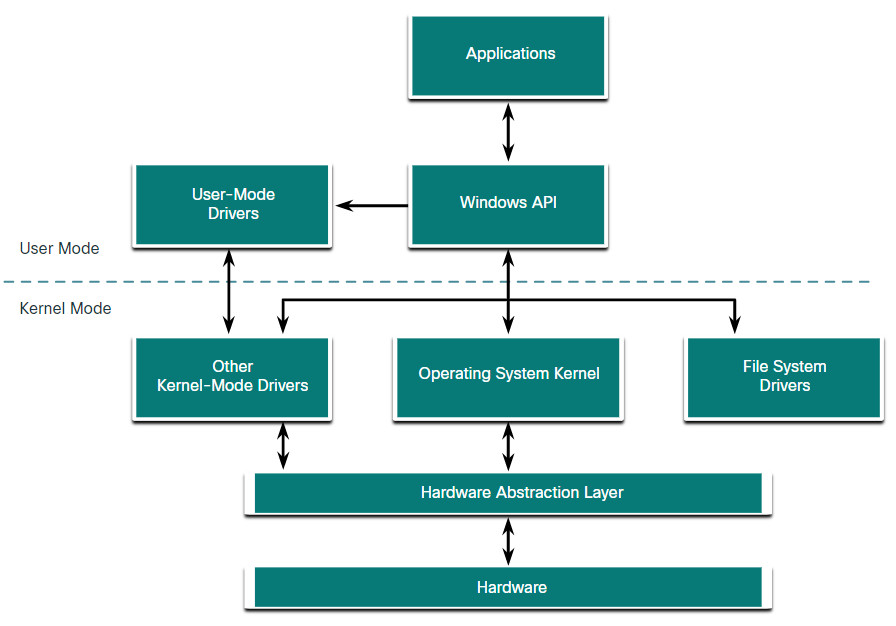
Installed applications run in user mode, and operating system code runs in kernel mode. Code that is executing in kernel mode has unrestricted access to the underlying hardware and is capable of executing any CPU instruction. Kernel mode code also can reference any memory address directly. Generally reserved for the most trusted functions of the OS, crashes in code running in kernel mode stop the operation of the entire computer. Conversely, programs such as user applications, run in user mode and have no direct access to hardware or memory locations. User mode code must go through the operating system to access hardware resources. Because of the isolation provided by user mode, crashes in user mode are restricted to the application only and are recoverable. Most of the programs in Windows run in user mode. Device drivers, pieces of software that allow the operating system and a device to communicate, may run in either kernel or user mode, depending on the driver.
All of the code that runs in kernel mode uses the same address space. Kernel-mode drivers have no isolation from the operating system. If an error occurs with the driver running in kernel mode, and it writes to the wrong address space, the operating system or another kernel-mode driver could be adversely affected. In this respect, the driver might crash, causing the entire operating system to crash.
When user mode code runs, it is granted its own restricted address space by the kernel, along with a process created specifically for the application. The reason for this functionality is mainly to prevent applications from changing operating system code that is running at the same time. By having its own process, that application has its own private address space, rendering other applications unable to modify the data in it. This also helps to prevent the operating system and other applications from crashing if that application crashes.
3.2.3 Windows File Systems
A file system is how information is organized on storage media. Some file systems may be a better choice to use than others, depending on the type of media that will be used. The table lists the file systems that Windows supports.
| Windows File System | Description |
|---|---|
| exFAT |
|
| Hierarchical File System Plus (HFS+) |
|
| Extended File System (EXT) |
|
| New Technology File System (NTFS) |
|
NTFS is the most widely used file system for Windows for many reasons. NTFS supports very large files and partitions and it is very compatible with other operating systems. NTFS is also very reliable and supports recovery features. Most importantly, it supports many security features. Data access control is achieved through security descriptors. These security descriptors contain file ownership and permissions all the way down to the file level. NTFS also tracks many time stamps to track file activity. Sometimes referred to as MACE, the timestamps Modify, Access, Create, and Entry Modified are often used in forensic investigations to determine the history of a file or folder. NTFS also supports file system encryption to secure the entire storage media.
Before a storage device such as a disk can be used, it must be formatted with a file system. In turn, before a file system can be put into place on a storage device, the device needs to be partitioned. A hard drive is divided into areas called partitions. Each partition is a logical storage unit that can be formatted to store information, such as data files or applications. During the installation process, most operating systems automatically partition and format the available drive space with a file system such as NTFS.
NTFS formatting creates important structures on the disk for file storage, and tables for recording the locations of files:
- Partition Boot Sector – This is the first 16 sectors of the drive. It contains the location of the Master File Table (MFT). The last 16 sectors contain a copy of the boot sector.
- Master File Table (MFT) – This table contains the locations of all the files and directories on the partition, including file attributes such as security information and timestamps.
- System Files – These are hidden files that store information about other volumes and file attributes.
- File Area – The main area of the partition where files and directories are stored.
Note: When formatting a partition, the previous data may still be recoverable because not all the data is completely removed. The free space can be examined, and files can be retrieved which can compromise security. It is recommended to perform a secure wipe on a drive that is being reused. The secure wipe will write data to the entire drive multiple times to ensure there is no remaining data.
3.2.4 Alternate Data Streams
NTFS stores files as a series of attributes, such as the name of the file, or a timestamp. The data which the file contains is stored in the attribute $DATA, and is known as a data stream. By using NTFS, you can connect Alternate Data Streams (ADSs) to the file. This is sometimes used by applications that are storing additional information about the file. The ADS is an important factor when discussing malware. This is because it is easy to hide data in an ADS. An attacker could store malicious code within an ADS that can then be called from a different file.
In the NTFS file system, a file with an ADS is identified after the filename and a colon, for example, Testfile.txt:ADS. This filename indicates an ADS called ADS is associated with the file called Testfile.txt. An example of ADS is shown in the command output.
C:\ADS> echo "Alternate Data Here" > Testfile.txt:ADS
C:\ADS> dir
Volume in drive C is Windows
Volume Serial Number is A606-CB1B
Directory of C:\ADS
2020-04-28 04:01 PM <DIR> .
2020-04-28 04:01 PM <DIR> ..
2020-04-28 04:01 PM 0 Testfile.txt
1 File(s) 0 bytes
2 Dir(s) 43,509,571,584 bytes free
C:\ADS> more < Testfile.txt:ADS
"Alternate Data Here"
C:\ADS> dir /r
Volume in drive C is Windows
Volume Serial Number is A606-CB1B
Directory of C:\ADS
2020-04-28 04:01 PM <DIR> .
2020-04-28 04:01 PM <DIR> ..
2020-04-28 04:01 PM 0 Testfile.txt
24 Testfile.txt:ADS:$DATA
1 File(s) 0 bytes
2 Dir(s) 43,509,624,832 bytes free
C:\ADS>
In the output:
- The first command places the text “Alternate Data Here” into an ADS of the file Testfile.txt called “ADS”.
- After that, dir, shows that the file was created, but the ADS is not visible.
- The next command shows that there is data in the Testfile.txt:ADS data stream.
- The last command shows the ADS of the Testfile.txt file because the r switch was used with the dir command.
3.2.5 Windows Boot Process
Many actions occur between the time that the computer power button is pressed and Windows is fully loaded, as shown in the figure. This is known as the Windows Boot process.
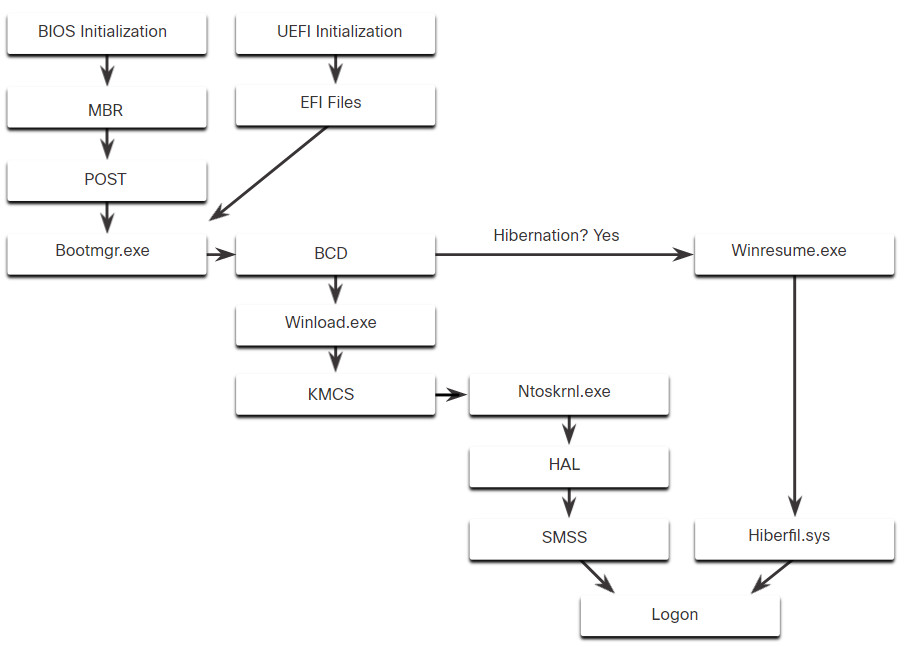
Two types of computer firmware exist:
- Basic Input-Output System (BIOS) – BIOS firmware was created in the early 1980s and works in the same way it did when it was created. As computers evolved, it became difficult for BIOS firmware to support all the new features requested by users.
- Unified Extensible Firmware Interface (UEFI) – UEFI was designed to replace BIOS and support the new features.
In BIOS firmware, the process begins with the BIOS initialization phase. This is when hardware devices are initialized and a power on self-test (POST) is performed to make sure all of these devices are communicating. When the system disk is discovered, the POST ends. The last instruction in the POST is to look for the master boot record (MBR).
The MBR contains a small program that is responsible for locating and loading the operating system. The BIOS executes this code and the operating system starts to load.
In contrast to BIOS firmware, UEFI firmware has a lot of visibility into the boot process. UEFI boots by loading EFI program files, stored as .efi files in a special disk partition, known as the EFI System Partition (ESP).
Note: A computer that uses UEFI stores boot code in the firmware. This helps to increase the security of the computer at boot time because the computer goes directly into protected mode.
Whether the firmware is BIOS or UEFI, after a valid Windows installation is located, the Bootmgr.exe file is run. Bootmgr.exe switches the system from real mode to protected mode so that all of the system memory can be used.
Bootmgr.exe reads the Boot Configuration Database (BCD). The BCD contains any additional code needed to start the computer, along with an indication of whether the computer is coming out of hibernation, or if this is a cold start. If the computer is coming out of hibernation, the boot process continues with Winresume.exe. This allows the computer to read the Hiberfil.sys file which contains the state of the computer when it was put into hibernation.
If the computer is being booted from a cold start, then the Winload.exe file is loaded. The Winload.exe file creates a record of the hardware configuration in the registry. The registry is a record of all of the settings, options, hardware, and software the computer has. The registry will be explored in depth later in this chapter. Winload.exe also uses Kernel Mode Code Signing (KMCS) to make sure that all drivers are digitally signed. This ensures that the drivers are safe to load as the computer starts.
After the drivers have been examined, Winload.exe runs Ntoskrnl.exe which starts the Windows kernel and sets up the HAL. Finally, the Session Manager Subsystem (SMSS) reads the registry to create the user environment, start the Winlogon service, and prepare each user’s desktop as they log on.
3.2.6 Windows Startup
There are two important registry items that are used to automatically start applications and services:
- HKEY_LOCAL_MACHINE – Several aspects of Windows configuration are stored in this key, including information about services that start with each boot.
- HKEY_CURRENT_USER – Several aspects related to the logged in user are stored in this key, including information about services that start only when the user logs on to the computer.
The registry will be discussed later in this topic.
Different entries in these registry locations define which services and applications will start, as indicated by their entry type. These types include Run, RunOnce, RunServices, RunServicesOnce, and Userinit. These entries can be manually entered into the registry, but it is much safer to use the Msconfig.exe tool. This tool is used to view and change all of the start-up options for the computer. Use the search box to find and open the Msconfig tool.
The Msconfig tool opens the System Configuration window. There are five tabs which contain the configuration options.
3.2.7 Windows Shutdown
It is always best to perform a proper shutdown to turn off the computer. Files that are left open, services that are closed out of order, and applications that hang can all be damaged if the power is turned off without first informing the operating system. The computer needs time to close each application, shut down each service, and record any configuration changes before power is lost.
During shutdown, the computer will close user mode applications first, followed by kernel mode processes. If a user mode process does not respond within a certain amount of time, the OS will display notification and allow the user to wait for the application to respond, or forcibly end the process. If a kernel mode process does not respond, the shutdown will appear to hang, and it may be necessary to shut down the computer with the power button.
There are several ways to shut down a Windows computer: Start menu power options, the command line command shutdown, and using Ctrl+Alt+Delete and clicking the power icon. There are three different options from which to choose when shutting down the computer:
- Shutdown – Turns the computer off (power off).
- Restart – Re-boots the computer (power off and power on).
- Hibernate – Records the current state of the computer and user environment and stores it in a file. Hibernation allows the user to pick up right where they left off very quickly with all their files and programs still open.
3.2.8 Processes, Threads, and Services
A Windows application is made up of processes. The application can have one or many processes dedicated to it. A process is any program that is currently executing. Each process that runs is made up of at least one thread. A thread is a part of the process that can be executed. The processor performs calculations on the thread. To configure Windows processes, search for Task Manager. The Processes tab of the Task Manager is shown in the figure.
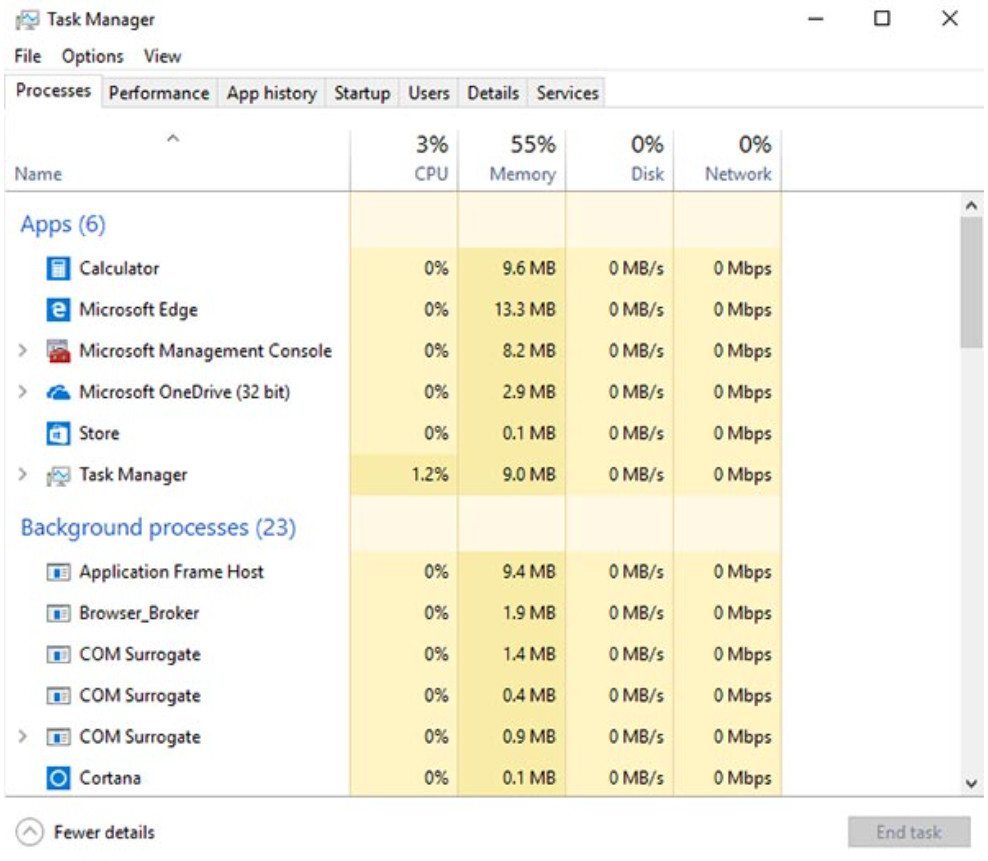
All of the threads dedicated to a process are contained within the same address space. This means that these threads may not access the address space of any other process. This prevents corruption of other processes. Because Windows multitasks, multiple threads can be executed at the same time. The amount of threads that can be executed at the same time is dependent on the number of the computer’s processors.
Some of the processes that Windows runs are services. These are programs that run in the background to support the operating system and applications. They can be set to start automatically when Windows boots or they can be started manually. They can also be stopped, restarted, or disabled.
Services provide long-running functionality, such as wireless or access to an FTP server. To configure Windows Services, search for services. The Windows Services control panel applet is shown in the figure.
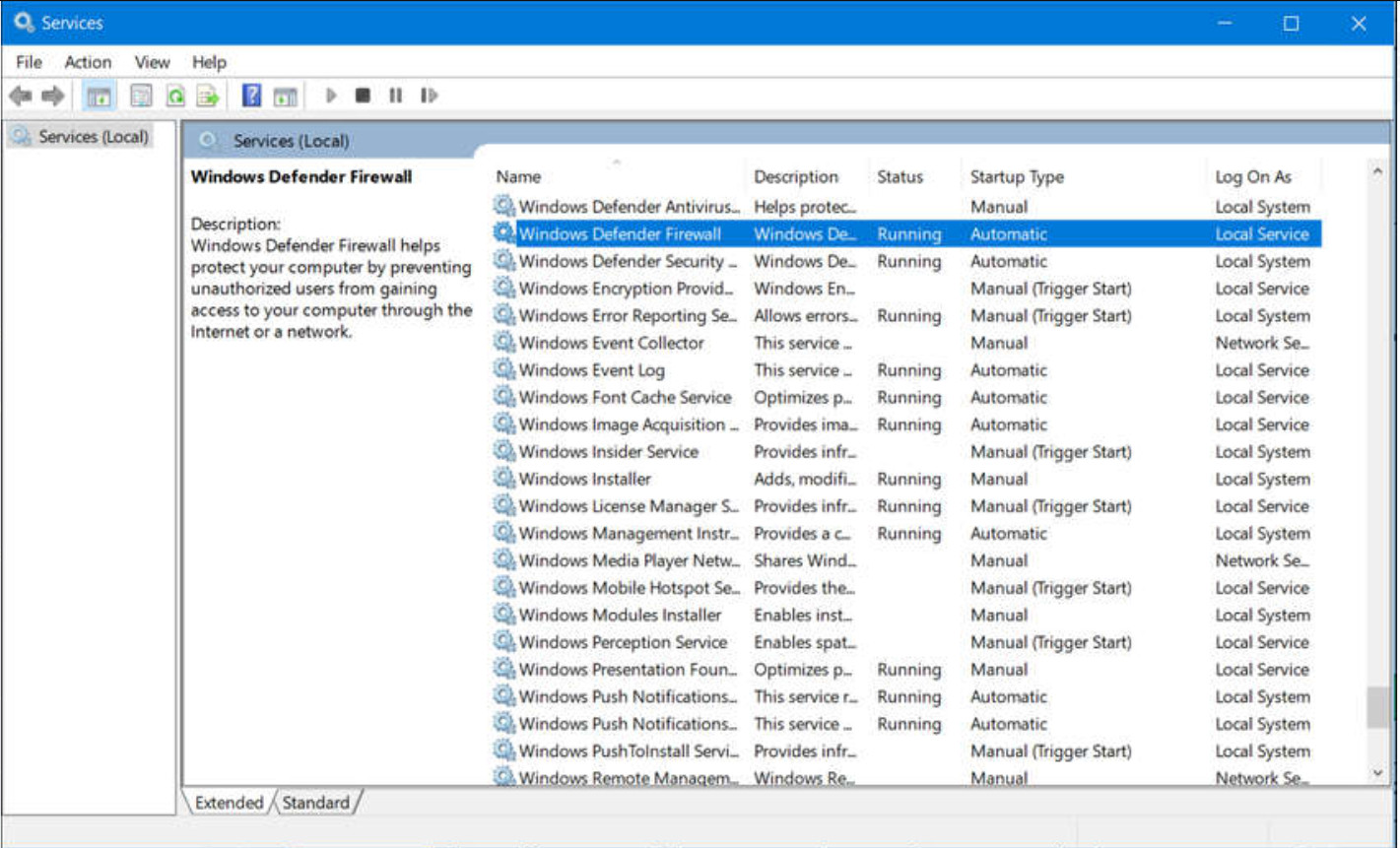
Be very careful when manipulating the settings of these services. Some programs rely on one or more services to operate properly. Shutting down a service may adversely affect applications or other services.
3.2.9 Memory Allocation and Handles
A computer works by storing instructions in RAM until the CPU processes them. The virtual address space for a process is the set of virtual addresses that the process can use. The virtual address is not the actual physical location in memory, but an entry in a page table that is used to translate the virtual address into the physical address.
Each process in a 32-bit Windows computer supports a virtual address space that enables addressing up to 4 gigabytes. Each process in a 64-bit Windows computer supports a virtual address space of 8 terabytes.
Each user space process runs in a private address space, separate from other user space processes. When the user space process needs to access kernel resources, it must use a process handle. This is because the user space process is not allowed to directly access these kernel resources. The process handle provides the access needed by the user space process without a direct connection to it.
A powerful tool for viewing memory allocation is RAMMap, which is shown in the figure. RAMMap is part of the Windows Sysinternals Suite of tools. It can be downloaded from Microsoft. RAMMap provides a wealth of information regarding how Windows has allocated system memory to the kernel, processes, drivers, and applications.
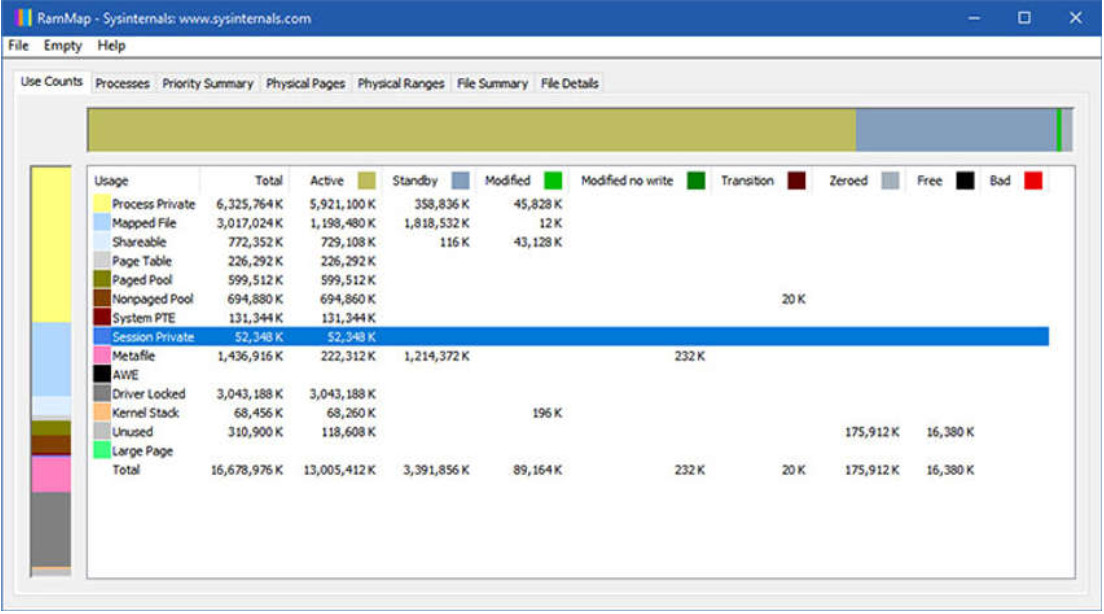
3.2.10 The Windows Registry
Windows stores all of the information about hardware, applications, users, and system settings in a large database known as the registry. The ways that these objects interact are also recorded, such as what files an application opens and all of the property details of folders and applications. The registry is a hierarchical database where the highest level is known as a hive, below that there are keys, followed by subkeys. Values store data and are stored in the keys and subkeys. A registry key can be up to 512 levels deep.
The table lists the five hives of the Windows registry.
| Registry Hive | Description |
|---|---|
| HKEY_CURRENT_USER (HKCU) | Holds information concerning the currently logged in user. |
| HKEY_USERS (HKU) | Holds information concerning all the user accounts on the host. |
| HKEY_CLASSES_ROOT (HKCR) | Holds information about object linking and embedding (OLE) registrations. OLE allows users to embed objects from other applications (like a spreadsheet) into a single document (like a Word document. |
| HKEY_LOCAL_MACHINE (HKLM) | Holds system-related information. |
| HKEY_CURRENT_CONFIG (HKCC) | Holds information about the current hardware profile. |
New hives cannot be created. The registry keys and values in the hives can be created, modified, or deleted by an account with administrative privileges. As shown in the figure, the tool regedit.exe is used to modify the registry. Be very careful when using this tool. Minor changes to the registry can have massive or even catastrophic effects.
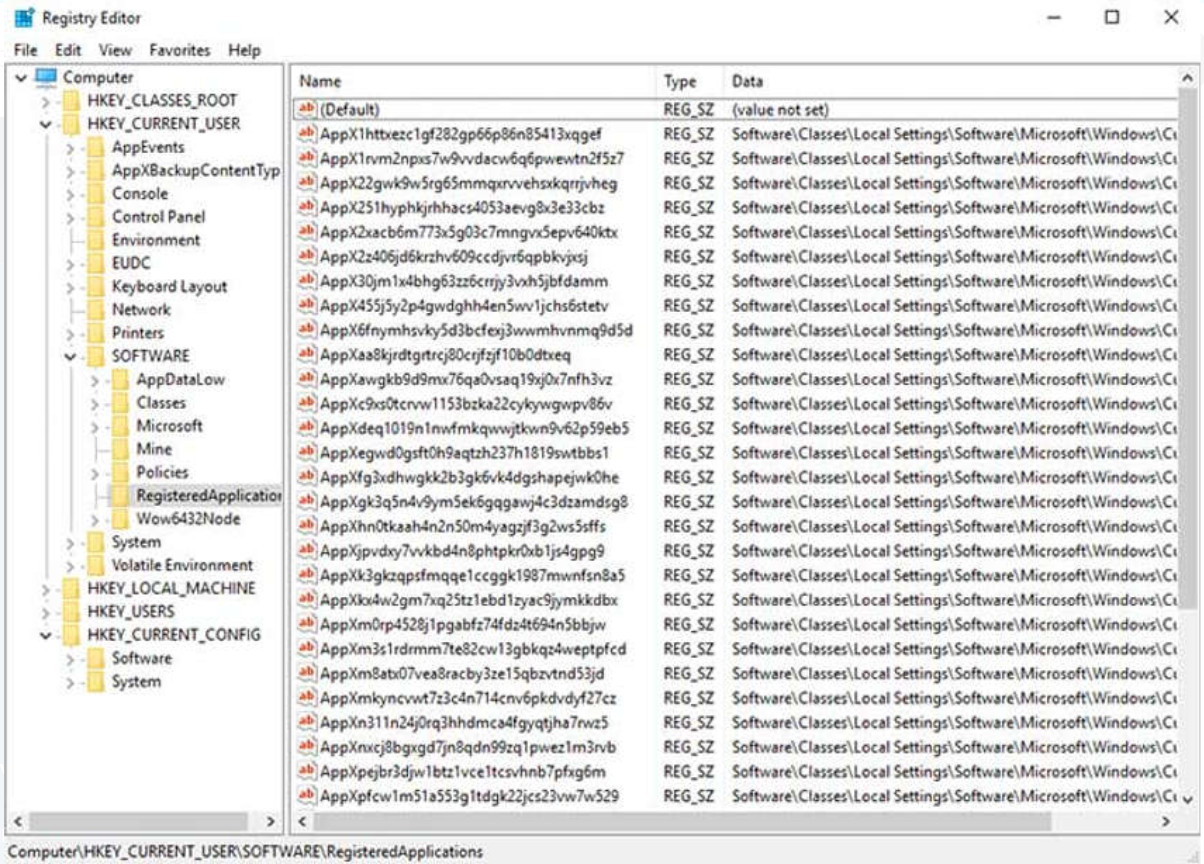
Navigation in the registry is very similar to Windows file explorer. Use the left panel to navigate the hives and the structure below it and use the right panel to see the contents of the highlighted item in the left panel. With so many keys and subkeys, the key path can become very long. The path is displayed at the bottom of the window for reference. Because each key and subkey is essentially a container, the path is represented much like a folder in a file system. The backslash (\) is used to differentiate the hierarchy of the database.
Registry keys can contain either a subkey or a value. The different values that keys can contain are as follows:
- REG_BINARY – Numbers or Boolean values
- REG_DWORD – Numbers greater than 32 bits or raw data
- REG_SZ – String values
Because the registry holds almost all the operating system and user information, it is critical to make sure that it does not become compromised. Potentially malicious applications can add registry keys so that they start when the computer is started. During a normal boot, the user will not see the program start because the entry is in the registry and the application displays no windows or indication of starting when the computer boots. A keylogger, for example, would be devastating to the security of a computer if it were to start at boot without the user’s knowledge or consent. When performing normal security audits, or remediating an infected system, review the application startup locations within the registry to ensure that each item is known and safe to run.
The registry also contains the activity that a user performs during normal day-to-day computer use. This includes the history of hardware devices, including all devices that have been connected to the computer including the name, manufacturer and serial number. Other information, such as what documents a user and program have opened, where they are located, and when they were accessed is stored in the registry. This is all very useful information when a forensics investigation needs to be performed.
3.2.11 Lab – Exploring Processes, Threads, Handles, and Windows Registry
In this lab, you will explore the processes, threads, and handles using Process Explorer in Sysinternals Suite. You will also use the Windows Registry to change a setting.
3.2.11 Lab – Exploring Processes, Threads, Handles, and Windows Registry
3.3 Windows Configuration and Monitoring
3.3.1 Run as Administrator
As a security best practice, it is not advisable to log on to Windows using the Administrator account or an account with administrative privileges. This is because any program that is executed while logged on with those privileges will inherit administrative privileges. Malware that has administrative privileges has full access to all the files and folders on the computer.
Sometimes, it is necessary to run or install software that requires the privileges of the Administrator. To accomplish this, there are two different ways to install it.
3.3.2 Local Users and Domains
When you start a new computer for the first time, or you install Windows, you will be prompted to create a user account. This is known as a local user. This account will contain all of your customization settings, access permissions, file locations, and many other user-specific data. There are also two other accounts that are present, the guest, and the administrator. Both of these accounts are disabled by default.
As a security best practice, do not enable the Administrator account and do not give standard users administrative privileges. If a user needs to perform any function that requires administrative privileges, the system will ask for the Administrator password and allow only that task to be performed as an administrator. Requiring the administrator password protects the computer by preventing any software that is not authorized from installing, executing, or accessing files.
The Guests account should not be enabled. The guest account does not have a password associated with it because it is created when a computer is going to be used by many different people who do not have accounts on the computer. Each time the guest account logs on, a default environment is provided to them with limited privileges.
To make administration of users easier, Windows uses groups. A group will have a name and a specific set of permissions associated with it. When a user is placed into a group, the permissions of that group are given to that user. A user can be placed into multiple groups to be provided with many different permissions. When the permissions overlap, certain permissions, like “explicitly deny” will override the permission provided by a different group. There are many different user groups built into Windows that are used for specific tasks. For example, the Performance Log Users group allows members to schedule logging of performance counters and collect logs either locally or remotely. Local users and groups are managed with the lusrmgr.msc control panel applet, as shown in the figure.
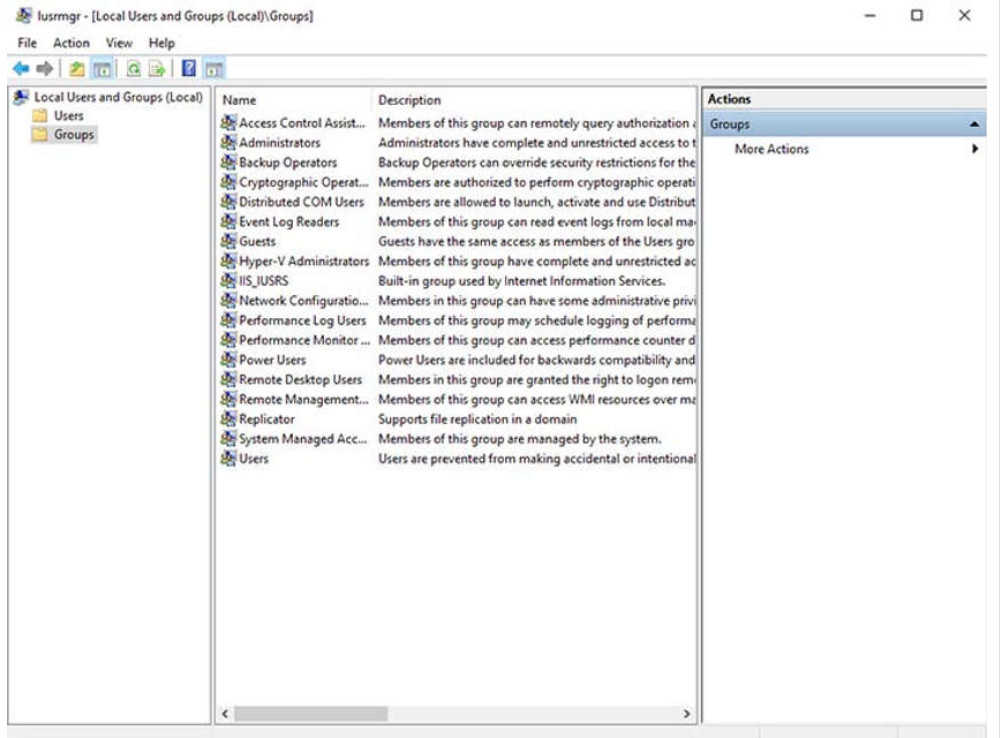
In addition to groups, Windows can also use domains to set permissions. A domain is a type of network service where all of the users, groups, computers, peripherals, and security settings are stored on and controlled by a database. This database is stored on special computers or groups of computers called domain controllers (DCs). Each user and computer on the domain must authenticate against the DC to logon and access network resources. The security settings for each user and each computer are set by the DC for each session. Any setting supplied by the DC defaults to the local computer or user account setting.
3.3.3 CLI and PowerShell
The Windows command line interface (CLI) can be used to run programs, navigate the file system, and manage files and folders. In addition, files called batch files can be created to execute multiple commands in succession, much like a basic script.
To open the Windows CLI, search for cmd.exe and click the program. Remember that right-clicking the program provides the option to Run as administrator, giving much more power to the commands that will be used.
The prompt displays the current location within the file system. These are a few things to remember when using the CLI:
- The file names and paths are not case-sensitive, by default.
- Storage devices are assigned a letter for reference. The drive letter is followed by a colon and backslash (\). This indicates the root, or highest level, of the device. Folder and file hierarchy on the device is indicated by separating them with the backslash. For example, the path C:\Users\Jim\Desktop\file.txt refers to a file called file.txt that is in the Desktop folder within the Jim folder within the Users folder at the root of drive C:.
- Commands that have optional switches use the forward slash (/) to delineate between the command and the switch option.
You can use the Tab key to auto-complete commands when directories or files are referenced.
- Windows keeps a history of the commands that were entered during a CLI session. Access previously entered commands by using the up and down arrow keys.
- To switch between storage devices, type the letter of the device, followed by a colon, and then press Enter.
Even though the CLI has many commands and features, it cannot work together with the core of Windows or the GUI. Another environment, called the Windows PowerShell, can be used to create scripts to automate tasks that the regular CLI is unable to create. PowerShell also provides a CLI for initiating commands. PowerShell is an integrated program within Windows and can be opened by searching for “powershell” and clicking the program. Like the CLI, PowerShell can also be run with administrative privileges.
These are the types of commands that PowerShell can execute:
- cmdlets – These commands perform an action and return an output or object to the next command that will be executed.
- PowerShell scripts – These are files with a .ps1 extension that contain PowerShell commands that are executed.
- PowerShell functions – These are pieces of code that can be referenced in a script.
To see more information about Windows PowerShell and get started using it, type help in PowerShell, as shown in the command output.
Windows PowerShell
Copyright (C) Microsoft Corporation. All rights reserved.
Try the new cross-platform PowerShell https://aka.ms/pscore6
PS C:\WINDOWS\system32> help
TOPIC
Windows PowerShell Help System
SHORT DESCRIPTION
Displays help about Windows PowerShell cmdlets and concepts.
LONG DESCRIPTION
Windows PowerShell Help describes Windows PowerShell cmdlets,
functions, scripts, and modules, and explains concepts, including
the elements of the Windows PowerShell language.
Windows PowerShell does not include help files, but you can read the
help topics online, or use the Update-Help cmdlet to download help files
to your computer and then use the Get-Help cmdlet to display the help
topics at the command line.
You can also use the Update-Help cmdlet to download updated help files
as they are released so that your local help content is never obsolete.
Without help files, Get-Help displays auto-generated help for cmdlets,
functions, and scripts.
ONLINE HELP
You can find help for Windows PowerShell online in the TechNet Library
beginning at http://go.microsoft.com/fwlink/?LinkID=108518.
To open online help for any cmdlet or function, type:
Get-Help -Online
UPDATE-HELP
To download and install help files on your computer:
1. Start Windows PowerShell with the "Run as administrator" option.
2. Type:
Update-Help
After the help files are installed, you can use the Get-Help cmdlet to
display the help topics. You can also use the Update-Help cmdlet to
download updated help files so that your local help files are always
up-to-date.
For more information about the Update-Help cmdlet, type:
Get-Help Update-Help -Online
-- More --
There are four levels of help in Windows PowerShell:
- get-help PS command – Displays basic help for a command
- get-help PS command [-examples] – Displays basic help for a command with examples
- get-help PS command [-detailed] – Displays detailed help for a command with examples
- get-help PS command [-full] – Displays all help information for a command with examples in greater depth
3.3.4
Windows Management Instrumentation
Windows Management Instrumentation (WMI) is used to manage remote computers. It can retrieve information about computer components, hardware and software statistics, and monitor the health of remote computers. To open the WMI control from the Control Panel, double-click Administrative Tools > Computer Management to open the Computer Management window, expand the Services and Applications tree and right-click the WMI Control icon > Properties.
The WMI Control Properties window is shown in the figure.
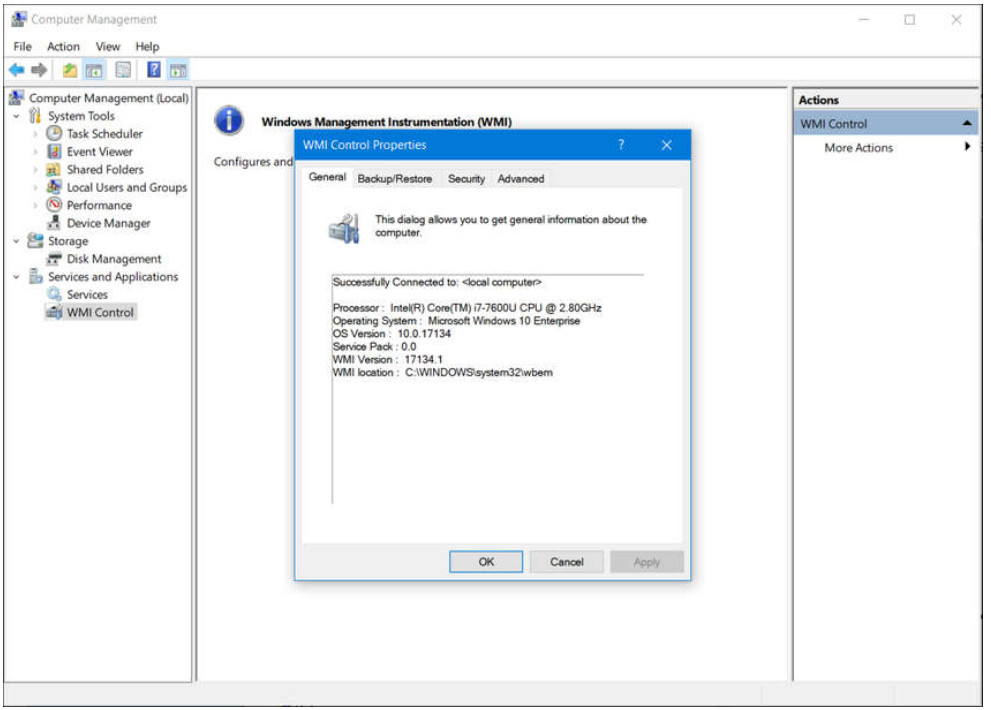
These are the four tabs in the WMI Control Properties window:
- General – Summary information about the local computer and WMI
- Backup/Restore – Allows manual backup of statistics gathered by WMI
- Security – Settings to configure who has access to different WMI statistics
- Advanced – Settings to configure the default namespace for WMI
Some attacks today use WMI to connect to remote systems, modify the registry, and run commands. WMI helps them to avoid detection because it is common traffic, most often trusted by the network security devices and the remote WMI commands do not usually leave evidence on the remote host. Because of this, WMI access should be strictly limited.
3.3.5 The net Command
Windows has many commands that can be entered at the command line. One important command is the net command, which is used in the administration and maintenance of the OS. The net command supports many subcommands that follow the net command and can be combined with switches to focus on specific output.
To see a list of the many net commands, type net help at the command prompt. The command output shows the commands that the net command can use. To see verbose help about any of the net commands, type C:\> net help, as shown below.
C:\> net help
The syntax of this command is:
NET HELP
command
-or-
NET command /HELP
Commands available are:
NET ACCOUNTS NET HELPMSG NET STATISTICS
NET COMPUTER NET LOCALGROUP NET STOP
NET CONFIG NET PAUSE NET TIME
NET CONTINUE NET SESSION NET USE
NET FILE NET SHARE NET USER
NET GROUP NET START NET VIEW
NET HELP
NET HELP NAMES explains different types of names in NET HELP syntax lines.
NET HELP SERVICES lists some of the services you can start.
NET HELP SYNTAX explains how to read NET HELP syntax lines.
NET HELP command | MORE displays Help one screen at a time.
C:\>
The table lists some common net commands.
| Command | Description |
|---|---|
| net accounts | Sets password and logon requirements for users |
| net session | Lists or disconnects sessions between a computer and other computers on the network |
| net share | Creates, removes, or manages shared resources |
| net start | Starts a network service or lists running network services |
| net stop | Stops a network service |
| net use | Connects, disconnects, and displays information about shared network resources |
| net view | Shows a list of computers and network devices on the network |
3.3.6 Task Manager and Resource Monitor
There are two very important and useful tools to help an administrator to understand the many different applications, services, and processes that are running on a Windows computer. These tools also provide insight into the performance of the computer, such as CPU, memory, and network usage. These tools are especially useful when investigating a problem where malware is suspected. When a component is not performing the way that it should be, these tools can be used to determine what the problem might be.
Task Manager
The Task Manager, which is shown in the figure, provides a lot of information about the software that is running and the general performance of the computer.

The table describes the seven tabs in the Task Manager.
| Task Manager Tabs | Description |
|---|---|
| Processes |
|
| Performance |
|
| App history |
|
| Startup |
|
| Users |
|
| Details |
|
| Services |
|
Resource Monitor
When more detailed information about resource usage is needed, you can use the Resource Monitor, as shown in the figure.
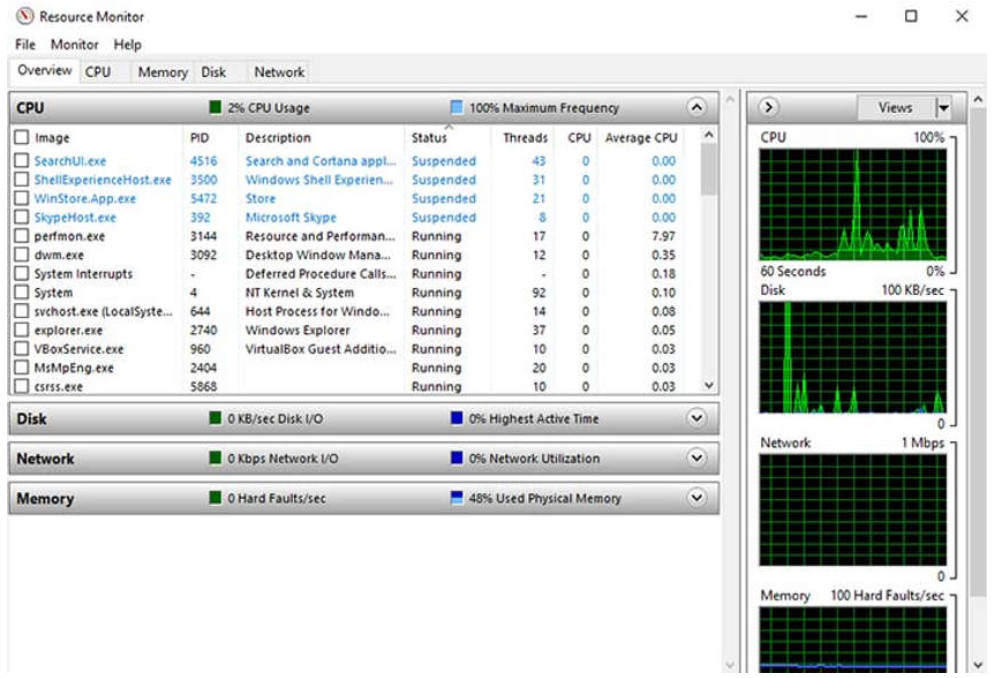
When searching for the reason a computer may be acting erratically, the Resource Monitor can help to find the source of the problem.
The table describes the five tabs of the Resource Monitor.
| Resource Monitor Tabs | Description |
|---|---|
| Overview |
|
| CPU |
|
| Memory |
|
| Disk | All of the processes that are using a disk are shown in this tab, with read/write statistics and an overview of each storage device. |
| Network |
|
3.3.7 Networking
One of the most important features of any operating system is the ability for the computer to connect to a network. Without this feature, there is no access to network resources or the internet. To configure Windows networking properties and test networking settings, the Network and Sharing Center is used. The easiest way to run this tool is to search for it and click it. Use the Network and Sharing Center to verify or create network connections, configure network sharing, and change network adapter settings.
Network and Sharing Center
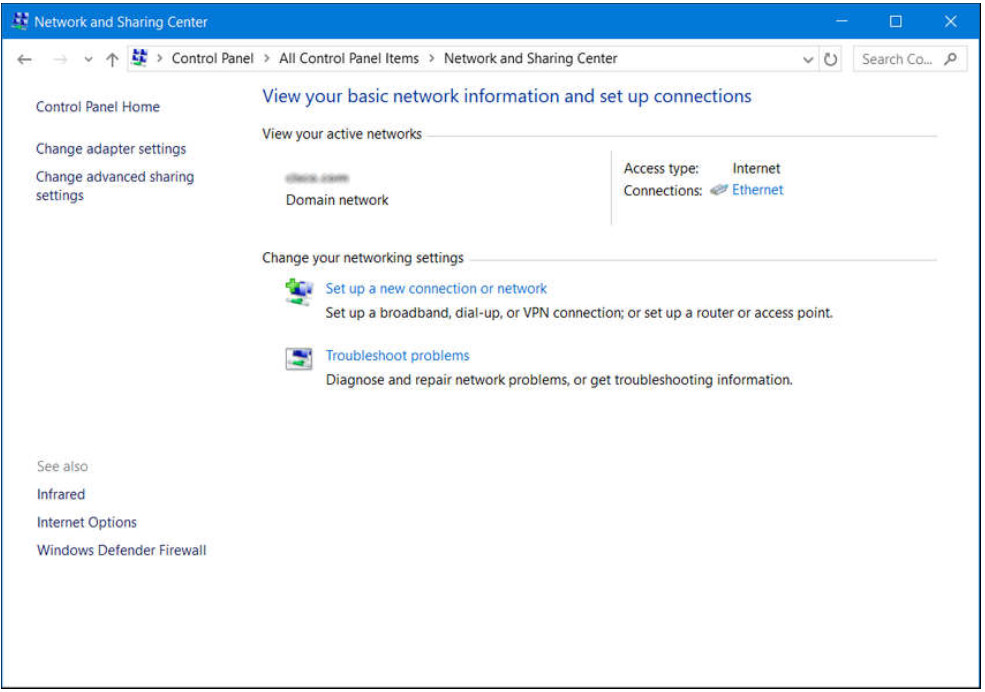
The initial view shows an overview of the active network. This view shows whether there is internet access and if the network is private, public, or guest. The type of network, either wired or wireless, is also shown. From this window, you can see the HomeGroup the computer belongs to, or create one if it is not already part of a HomeGroup. This tool can also be used to change adapter settings, change advance sharing settings, set up a new connection, or troubleshoot problems. Note that HomeGroup was removed from Windows 10 in version 1803.
Change Adapter Settings
To configure a network adapter, choose Change adapter settings in the Networking and Sharing Center to show all of the network connections that are available. Select the adapter that you want to configure. In this case, we change an Ethernet adapter to acquire its IPv4 address automatically from the network.
nslookup and netstat
Domain Name System (DNS) should also be tested because it is essential to finding the address of hosts by translating it from a name, such as a URL. Use the nslookup command to test DNS. Type nslookup cisco.com at the command prompt to find the address of the Cisco webserver. When the address is returned, you know that DNS is functioning correctly. You can also check to see what ports are open, where they are connected, and what their current status is. Type netstat at the command line to see details of active network connections, as shown in the command output. The netstat command will be examined further later in this module.
C:\Users\USER>netstat Active Connections Proto Local Address Foreign Address State TCP 127.0.0.1:3030 USER-VGFFA:58652 ESTABLISHED TCP 127.0.0.1:3030 USER-VGFFA:62114 ESTABLISHED TCP 127.0.0.1:3030 USER-VGFFA:62480 TIME_WAIT TCP 127.0.0.1:3030 USER-VGFFA:62481 TIME_WAIT TCP 127.0.0.1:3030 USER-VGFFA:62484 TIME_WAIT
3.3.8 Accessing Network Resources
Like other operating systems, Windows uses networking for many different applications such as web, email, and file services. Originally developed by IBM, Microsoft aided in the development of the Server Message Block (SMB) protocol to share network resources. SMB is mostly used for accessing files on remote hosts. The Universal Naming Convention (UNC) format is used to connect to resources, for example:
\\servername\sharename\file
In the UNC, servername is the server that is hosting the resource. This can be a DNS name, a NetBIOS name, or simply an IP address. The sharename is the root of the folder in the file system on the remote host, while the file is the resource that the local host is trying to find. The file may be deeper within the file system and this hierarchy will need to be indicated.
When sharing resources on the network, the area of the file system that will be shared will need to be identified. Access control can be applied to the folders and files to restrict users and groups to specific functions such as read, write, or deny. There are also special shares that are automatically created by Windows. These shares are called administrative shares. An administrative share is identified by the dollar sign ($) that comes after the share name. Each disk volume has an administrative share, represented by the volume letter and the $ such as C$, D$, or E$. The Windows installation folder is shared as admin$, the printers’ folder is shared as print$, and there are other administrative shares that can be connected. Only users with administrative privileges can access these shares.
The easiest way to connect to a share is to type the UNC of the share into the Windows File Explorer, in the box at the top of the screen which shows the breadcrumb listing of the current file system location. When Windows tries to connect to the share, you will be asked to provide credentials for accessing the resource. Remember that because the resource is on a remote computer, the credentials need to be for the remote computer, not the local computer.
Besides accessing shares on remote hosts, you can also log in to a remote host and manipulate that computer, as if it were local, to make configuration changes, install software, or troubleshoot an issue. In Windows, this feature uses the Remote Desktop Protocol (RDP). When investigating security incidents, a security analyst uses RDP often to access remote computers. To start RDP and connect to a remote computer, search for remote desktop and click the application. The Remote Desktop Connection window is shown in the figure.
Because RDP is designed to permit remote users to control individual hosts, it is a natural target for threat actors. Care should be taken when activating RDP, especially on unpatched legacy versions of Windows such as those that are still found in industrial control systems. Care should be taken to limit the exposure of RDP to the internet, and security approaches and access control policies, such as Zero Trust, should be used to limit access to internal hosts.

3.3.9 Windows Server
Most Windows installations are performed as desktop installations on desktops and laptops. There is another edition of Windows that is mainly used in data centers called Windows Server. This is a family of Microsoft products that began with Windows Server 2003. Windows Server hosts many different services and can fulfill different roles within a company.
Note: Although there is a Windows Server 2000, it is considered a client version of Windows NT 5.0. Windows Server 2003 is a server based on NT 5.2 and begins a new family of Windows Server versions.
These are some of the services that Windows Server provides:
- Network Services – DNS, DHCP, Terminal services, Network Controller, and Hyper-V Network virtualization
- File Services – SMB, NFS, and DFS
- Web Services – FTP, HTTP, and HTTPS
- Management – Group policy and Active Directory domain services control
3.3.10 Lab – Create User Accounts
In this lab, you will create and modify user accounts in Windows.
3.3.10 Lab – Create User Accounts
3.3.11 Lab – Using Windows PowerShell
The objective of the lab is to explore some of the functions of PowerShell.
3.3.11 Lab – Using Windows PowerShell
3.3.12 Lab – Windows Task Manager
In this lab, you will explore Task Manager and manage processes from within Task Manager.
3.3.12 Lab – Windows Task Manager
3.3.13 Lab – Monitor and Manage System Resources in Windows
In this lab, you will use administrative tools to monitor and manage system resources.
3.3.13 Lab – Monitor and Manage System Resources in Windows
3.4 Windows Security
3.4.1 The netstat Command
When malware is present in a computer, it will often open communication ports on the host to send and receive data. The netstat command can be used to look for inbound or outbound connections that are not authorized. When used on its own, the netstat command will display all of the active TCP connections.
By examining these connections, it is possible to determine which of the programs are listening for connections that are not authorized. When a program is suspected of being malware, a little research can be performed to determine its legitimacy. From there, the process can be shut down with Task Manager, and malware removal software can be used to clean the computer.
To make this process easier, you can link the connections to the running processes that created them in Task Manager. To do this, open a command prompt with administrative privileges and enter the netstat -abno command, as shown in the command output.
Microsoft Windows [Version 10.0.18363.720] (c) 2019 Microsoft Corporation. All rights reserved. C:\WINDOWS\system32> netstat -abno Active Connections Proto Local Address Foreign Address State PID TCP 0.0.0.0:80 0.0.0.0:0 LISTENING 4 Can not obtain ownership information TCP 0.0.0.0:135 0.0.0.0:0 LISTENING 952 RpcSs [svchost.exe] TCP 0.0.0.0:445 0.0.0.0:0 LISTENING 4 Can not obtain ownership information TCP 0.0.0.0:623 0.0.0.0:0 LISTENING 14660 [LMS.exe] TCP 0.0.0.0:3389 0.0.0.0:0 LISTENING 1396 TermService [svchost.exe] TCP 0.0.0.0:5040 0.0.0.0:0 LISTENING 9792 CDPSvc [svchost.exe] TCP 0.0.0.0:5357 0.0.0.0:0 LISTENING 4 Can not obtain ownership information TCP 0.0.0.0:5593 0.0.0.0:0 LISTENING 4 Can not obtain ownership information TCP 0.0.0.0:8099 0.0.0.0:0 LISTENING 5248 [SolarWinds TFTP Server.exe] TCP 0.0.0.0:16992 0.0.0.0:0 LISTENING 14660
Note: If you are not in administrator mode, a “The requested operation requires elevation” message will appear. Search for Command Prompt. Right-click on Command Prompt and chose Run as administrator.
By examining the active TCP connections, an analyst should be able to determine if there are any suspicious programs that are listening for incoming connections on the host. You can also trace that process to the Windows Task Manager and cancel the process. There may be more than one process listed with the same name. If this is the case, use the PID to find the correct process. Each process running on the computer has a unique PID. To display the PIDs for the processes in the Task Manager, open the Task Manager, right-click the table heading and select PID.
3.4.2 Event Viewer
Windows Event Viewer logs the history of application, security, and system events. These log files are a valuable troubleshooting tool because they provide information necessary to identify a problem. To open the Event Viewer, search for it and click the program icon, as shown in the figure.
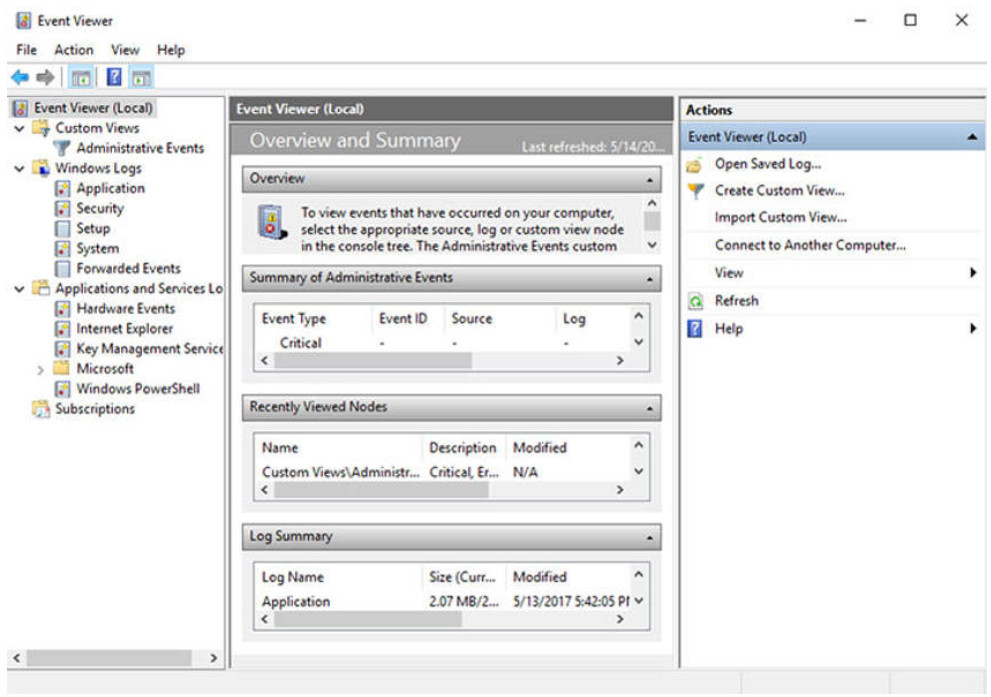
Windows includes two categories of event logs: Windows Logs, and Application and Services Logs. Each of these categories has multiple log types. Events that are displayed in these logs have a level: information, warning, error, or critical. They also have the date and time that the event occurred, along with the source of the event and an ID which relates to that type of event.
It is also possible to create a custom view. This is useful when looking for certain types of events, finding events that happened during a certain time period, displaying events of a certain level, and many other criteria. There is a built-in custom view called Administrative Events that shows all critical, error, and warning events from all of the administrative logs. This is a good view to start with when trying to troubleshoot a problem.
Security event logs are found under Windows Logs. They use event IDs to identify the type of event.
3.4.3 Windows Update Management
No software is perfect, and the Windows operating system is no exception. Attackers are constantly coming up with new ways to compromise computers and exploit bad code. Some of these attacks come so quickly that defenses against them have not yet been devised and distributed. These are called zero-day exploits. Microsoft and security software developers are always trying to stay ahead of the attackers, but they are not always successful. To ensure the highest level of protection against these attacks, always make sure Windows is up to date with the latest service packs and security patches.
Patches are code updates that manufacturers provide to prevent a newly discovered virus or worm from making a successful attack. From time to time, manufacturers combine patches and upgrades into a comprehensive update application called a service pack. Many devastating virus attacks could have been much less severe if more users had downloaded and installed the latest service pack. It is highly desirable that enterprises utilize systems that automatically distribute, install, and track security updates.
Windows routinely checks the Windows Update website for high-priority updates that can help protect a computer from the latest security threats. These updates include security updates, critical updates, and service packs. Depending on the setting you choose, Windows automatically downloads and installs any high-priority updates that your computer needs or notifies you as these updates become available. To configure the settings for Windows update, search for Windows Update and click the application.
Update status, shown in the figure, allows you to check for updates manually and see the update history of the computer.
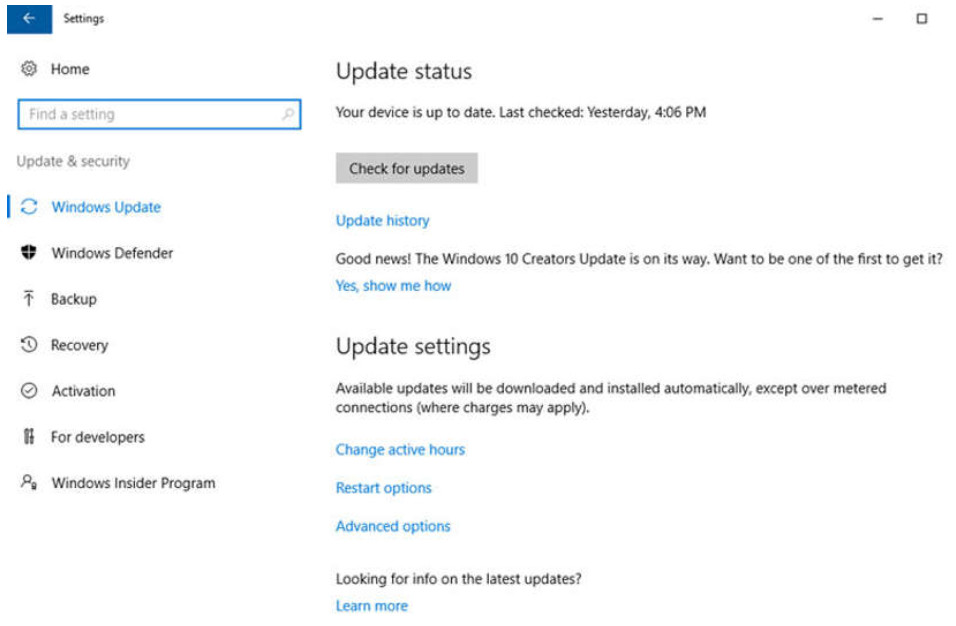
There are also settings for the hours where the computer will not automatically restart, for example during regular business hours. You can also choose when to restart the computer after an update, if necessary, with the Restart options. Advanced options are also available to choose how updates are installed how other Microsoft products are updated.
3.4.4 Local Security Policy
A security policy is a set of objectives that ensures the security of a network, the data, and the computer systems in an organization. The security policy is a constantly evolving document based on changes in technology, business, and employee requirements.
In most networks that use Windows computers, Active Directory is configured with Domains on a Windows Server. Windows computers join the domain. The administrator configures a Domain Security Policy that applies to all computers that join the domain. Account policies are automatically set when a user logs in to a computer that is a member of a domain. Windows Local Security Policy, shown in the figure, can be used for stand-alone computers that are not part of an Active Directory domain. To open the Local Security Policy applet, search for Local Security Policy and click the program.
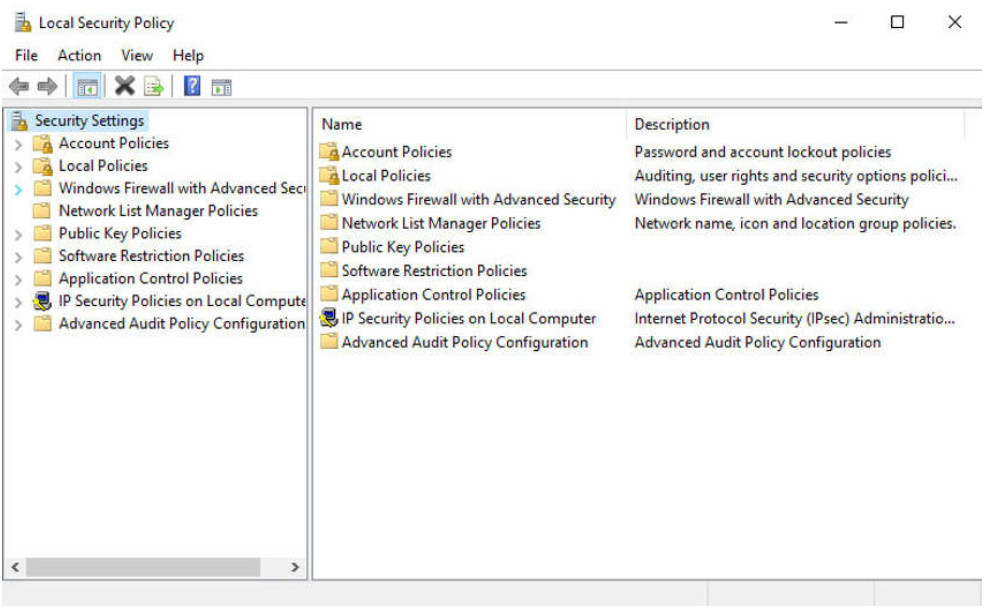
Password guidelines are an important component of a security policy. Any user that must log on to a computer or connect to a network resource should be required to have a password. Passwords help prevent theft of data and malicious acts. Passwords also help to confirm that the logging of events is valid by ensuring that the user is the person that they say they are. In the Local Security Policy, Password Policy is found under Account Policies and defines the criteria for the passwords for all of the users on the local computer.
Use the Account Lockout Policy in Account Policies to prevent brute-force login attempts. For example, you can set the policy to allow the user to enter a wrong username and/or password five times. After five attempts, the account is locked for 30 minutes. After 30 minutes, the number of attempts is reset to zero and the user can attempt to login again.
It is important to make sure that computers are secure when users are away. A security policy should contain a rule about requiring a computer to lock when the screensaver starts. This will ensure that after a short time away from the computer, the screen saver will start and then the computer cannot be used until the user logs in.
If the Local Security Policy on every stand-alone computer is the same, then use the Export Policy feature. Save the policy with a name, such as workstation.inf. Copy the policy file to an external media or network drive to use on other stand-alone computers. This is particularly helpful if the administrator needs to configure extensive local policies for user rights and security options.
The Local Security Policy applet contains many other security settings that apply specifically to the local computer. You can configure User Rights, Firewall Rules, and even the ability to restrict the files that users or groups are allowed to run with the AppLocker.
3.4.5 Windows Defender
Malware includes viruses, worms, Trojan horses, keyloggers, spyware, and adware. These are designed to invade privacy, steal information, damage the computer, or corrupt data. It is important that you protect computers and mobile devices using reputable antimalware software. The following types of antimalware programs are available:
- Antivirus protection – This program continuously monitors for viruses. When a virus is detected, the user is warned, and the program attempts to quarantine or delete the virus.
- Adware protection – This program continuously looks for programs that display advertising on your computer.
- Phishing protection – This program blocks the IP addresses of known phishing websites and warns the user about suspicious sites.
- Spyware protection – This program scans for keyloggers and other spyware.
- Trusted / untrusted sources – This program warns you about unsafe programs about to be installed or unsafe websites before they are visited.
It may take several different programs and multiple scans to completely remove all malicious software. Run only one malware protection program at a time.
Several reputable security organizations such as McAfee, Symantec, and Kaspersky offer all-inclusive malware protection for computers and mobile devices. Windows has built-in virus and spyware protection called Windows Defender, as shown in the figure. Windows Defender is turned on by default to provide real-time protection against infection.
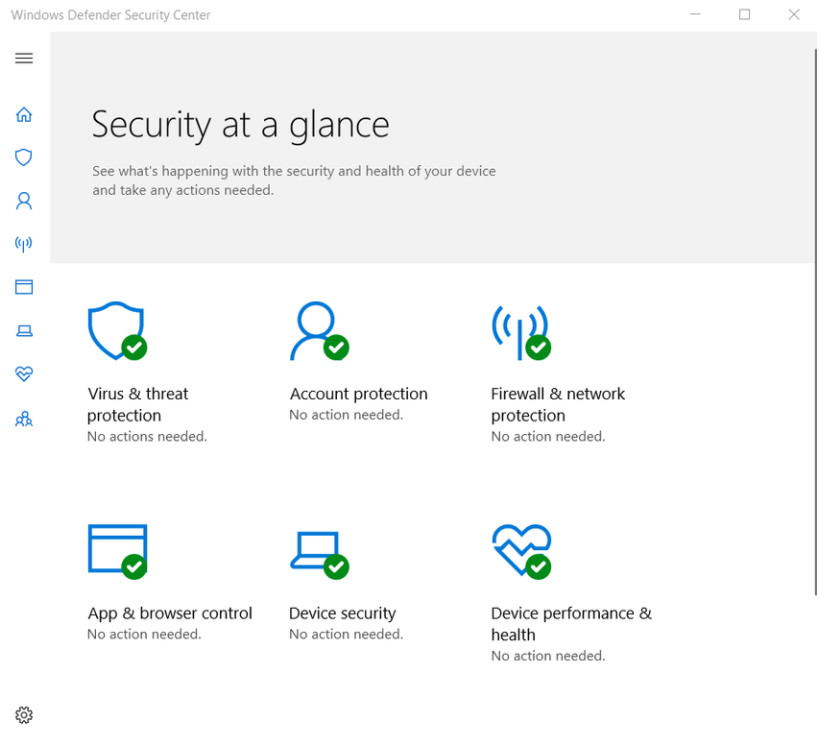
To open Windows Defender, search for it and click the program. Although Windows Defender works in the background, you can perform manual scans of the computer and storage devices. You can also manually update the virus and spyware definitions in the Update tab. Also, to see all of the items that were found during previous scans, click the History tab.
3.4.6 Windows Defender Firewall
A firewall selectively denies traffic to a computer or network segment. Firewalls generally work by opening and closing the ports used by various applications. By opening only the required ports on a firewall, you are implementing a restrictive security policy. Any packet not explicitly permitted is denied. In contrast, a permissive security policy permits access through all ports, except those explicitly denied. In the past, software and hardware were shipped with permissive settings. As users neglected to configure their equipment, the default permissive settings left many devices exposed to attackers. Most devices now ship with settings as restrictive as possible, while still allowing easy setup.
To allow program access through the Windows Defender Firewall, search for Control Panels. Under Systems and Security, locate Windows Defender Firewall. Click Allow an app or feature through Windows Defender Firewall, as shown in the figure.
If you wish to use a different software firewall, you will need to disable Windows Firewall. To disable the Windows Firewall, click Turn Windows Firewall on or off.
Many additional settings can be found under Advanced settings. Here you can create inbound or outbound traffic rules based on different criteria. You can also import and export policies or monitor different aspects of the firewall.
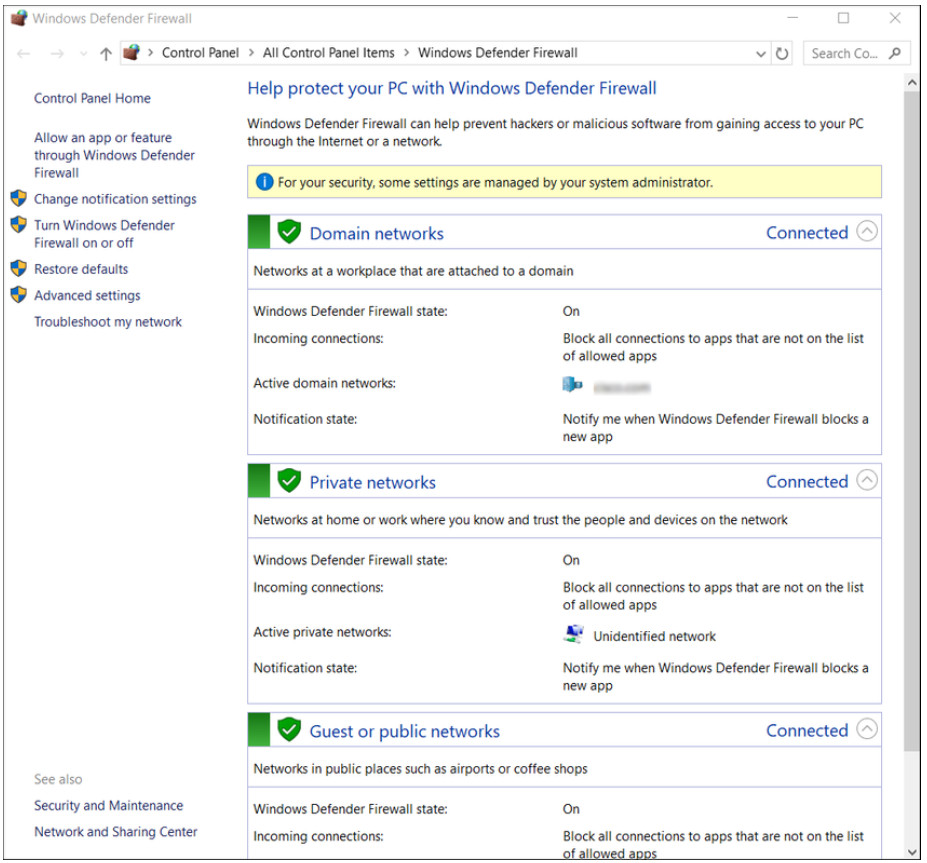
3.5 The Windows Operating System Summary
3.5.1 What Did I Learn in this Module?
Windows History
The first computers required a Disk Operating System (DOS) to create and manage files. Microsoft developed MS-DOS as a command line interface (CLI) to access the disk drive and load the operating system files. Early versions of Windows consisted of a Graphical User Interface (GUI) that ran over MS-DOS. However, modern Windows versions are in direct control of the computer and its hardware and support multiple user processes. This is much different than the single process, single user MS-DOS. Since 1993, there have been more than 20 releases of Windows that are based on the NT operating system. Users use a Windows GUI to work with data files and software. The GUI has a main area that is known as the Desktop and a Task Bar situated below the desktop. The Task Bar includes the Start menu, quick launch icons, and a notification area. Windows has many vulnerabilities. Recommendations to secure the Windows OS include use of virus or malware protection, use of strong passwords, use of firewall, and limited use of the administrator account, among others.
Windows Architecture and Operations
Windows consists of a hardware abstraction layer (HAL) that is software that handles all of the communication between the hardware and the kernel. The kernel has control over the entire computer and handles input and output requests, memory, and all of the peripherals connected to the computer. Windows operates in two different modes. The first is user mode. Most Windows programs run in user mode. The second is kernel mode. It allows operating system code direct access to the computer hardware. Windows supports several different file systems, but NTFS is the most widely used. NTFS volumes include the partition boot sector, master file table, system files and the file area. When a computer boots, it first accesses system information and code that is stored in BIOS hardware. The BIOS boot code performs a system self-test called POST, locates and loads the Windows OS, and loads other associated programs to start the operating system. Windows should always be shutdown properly.
A computer works by storing instructions in RAM until the CPU processes them. Each process in a 32-bit Windows computer supports a virtual address space that enables addressing up to 4 gigabytes. Each process in a 64-bit Windows computer supports a virtual address space of up to 8 terabytes. Windows stores all of the information about hardware, applications, users, and system settings in a large database known as the registry. The registry is a hierarchical database where the highest level is known as a hive, below that there are keys, followed by subkeys. There are five registry hives that contain data regarding the configuration and operation of Windows. There are hundreds of keys and subkeys.
Windows Configuration and Monitoring
For security reasons, it is not advisable to log on to Windows using the Administrator account or an account with administrative privileges. Do not give standard users administrative privileges. Do not enable the Guests account unless the computer is going to be used by many different people who do not have accounts. Use Windows groups to make administration of users easier. Local users and groups are managed with the lusrmgr.msc control panel applet.
You can use the CLI or the Windows PowerShell to execute commands. PowerShell can be used to create scripts to automate tasks that the regular CLI is unable to automate. Windows Management Instrumentation (WMI) is used to manage remote computers. The net command can be combined with switches to focus on specific output. Task Manager provides a lot of information about what is running, and the general performance of the computer. The Resource Monitor provides more detailed information about resource usage. The Network and Sharing Center is used to configure Windows networking properties and test networking settings. The Server Message Block (SMB) protocol is used to share network resources such as files on remote hosts. The Universal Naming Convention (UNC) format is used to connect to resources. Windows Server is an edition of Windows that is mainly used in data centers. It provides network, file, web, and management services to a Windows network or domain.
Windows Security
Malware can open communication ports to communicate and spread. The Windows netstat command displays all open communication ports on a computer and can also display the software processes that are associated with the ports. This enables unknown potentially malicious software to be identified and shutdown. Windows Event Viewer provides access to numerous logged events regarding the operation of a computer. Windows logs Windows events and applications and services events. Logged event severity levels range through the information, warning, error, or critical levels. It is very import to keep Windows up to date to guard against new security threats. Software patches, updates, and service packs address security vulnerabilities as they are discovered. Windows should be configured to automatically download and install updates as they become available. Windows can be configured to only install and restart a computer at specified times of day.

